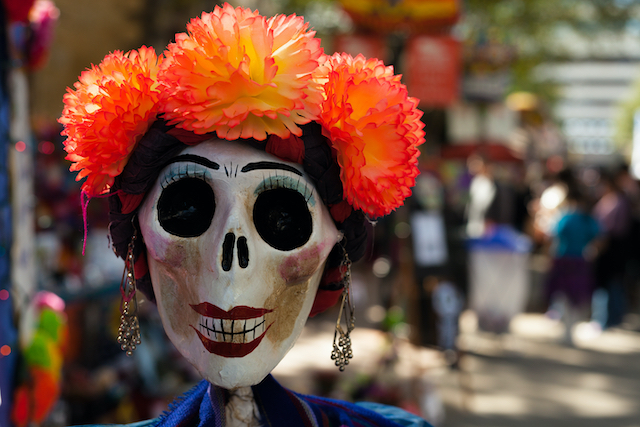
In the Spanish-speaking world, the end of October marks the celebration of el Dia de los Muertos, or the Day of the Dead.
In the English-speaking world, the end of the month of October is marked by the celebration of Halloween. This day began as a pagan Celtic festival when people would light up bonfires and wear costumes to ward away ghosts – over time this morphed into our recognizable traditions of trick or treating and wearing costumes. However, in the Spanish-speaking world, the end of October marks the celebration of el Dia de los Muertos, or the Day of the Dead. This is not simply a Mexican spin on Halloween, contrary to popular belief. It is a full-fledged two day long celebration of life and death with much different traditions that is recognized throughout the world. Let’s take a deeper dive into the traditions associated with el Dia de los Muertos.
Calaveras and Ofrendas
The most recognizable symbol of Day of the Dead celebrations is the calaveras. This is a skull that is decorated with a colorful flourish, typically made to look like it is smiling or laughing. The calaveras takes many forms during the celebrations – it is made into pieces of art like sculptures, baked into edible candies, and painted on the faces of those celebrating the holidays.
However, the most meaningful symbol of el Dia de los Muertos is the ofrenda, or offering. During each part of the celebration, offerings are made to the deceased members of one’s family as a way of honoring them. A miniature altar is constructed for the loved one that is decorated with a bright colored oil cloth, photographs, and personal belongings. On the lower section of the altar, family and friends place their ofrendas for the loved one, typically consisting of traditional Mexican food, tequila, or other items that the family member liked while they were alive.
The Three Celebrations of El Dia de los Muertos
The revelry of the Day of the Dead is broken up into three parts over the course of the two days. On November 1st at midnight, families celebrate Dia de los Angelitos, or Day of the Little Angels. It is believed that, during the next 24 hours, the spirits of all deceased children are reunited with their families for a celebration. Ofrendas such as toys and snacks are given on the altars dedicated to these children. On November 2nd at midnight, families celebrate Dia de los Difuntos, or Day of the Deceased, where the focus shifts to the spirits of departed adults. Families play games with each other and reminisce about their loved ones.
Noon on the 2nd marks the grand finale of these celebrations, where everyone in their local communities come together for a public celebration of life and death. People dress up, paint their faces with the calavera image, and parade and dance in the streets. Families also typically visit grave sites to decorate with marigolds and gifts. It is also customary to clean the grave stone as a sign of respect and honor.
Explore the World with AESU!
Are you ready to plan an adventure of a lifetime? AESU offers unique, thrilling travel programs for college students and young professionals at affordable rates. Each trip is action-packed and informal—designed just for people your own age. We are also able to design custom tours just for your group.
Experience an exhilarating adventure in 2022 on the Cosmopolitan, Great Escape, Greek Island Hopper tour, and more! 2022 tour dates are now available! If you have any questions or want help booking your next adventure, please contact AESU by calling 800-638-7640, or fill out the contact form found on our website. Follow AESU on Facebook, Twitter, Instagram, LinkedIn, and Pinterest.
